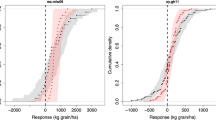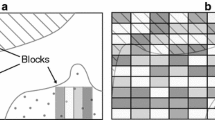Abstract
In many developing countries, fertilizer recommendations must be made in the absence of plant and soil analyses. When the region is variable in terms of soils, weather, and magnitude of response to fertilizer, a recommendation is likely to involve a high degree of risk for the farmer. Quantification of such risk is key to developing appropriate recommendations for the farmer. However, most methodologies generally used in analyzing fertilizer trials do not allow adequate quantification, especially as a continuous function, of the risk associated with a given recommendation. Three years of on-farm trials conducted in the High Valley of Mexico were used to evaluate different methodologies for generating N fertilization recommendations and their associated risk for wheat (Triticum aestivum) production in the absence of soil tests. When the traditional approach, using average yield responses or separate trial results, was used, an economic optimum was identified, but it was not possible to quantify the associated risk. In contrast, however, by using a combination of response surface methodology and simple probability analysis, the risk associated with any given recommendation was developed, even under the highly variable conditions of the study zone. The approach uses a treatment difference matrix (developed using average yield differences between a treatment and the zero N (0N) check) and its associated standard deviation over locations. From the matrix, an equation (being a function of N rate and relative grain:N price ratios) was developed that shows the probability of outperforming the 0N check for the economic optimum rate.
Similar content being viewed by others
References
Anderson JR (1974) Risk efficiency in the interpretation of agricultural production research. Review of Marketing and Agric Econ 42: 131–184.
Anderson JR and Dillon JL (1992) Risk analysis in dryland farming systems. Farm Systems Management Series 2, pp 52–59. Food and Agriculture Organization, Rome.
Anderson RL and Nelson LA (1975) A family of models involving intersecting straight lines and concomitant experimental designs useful in evaluating response to fertilizer nutrients. Biometrics 31: 303–318.
Bray RH (1948) Correlation of soil tests with crop response to added fertilizers and with fertilizer requirements. In: Kitchen HB (ed) Diagnostic Techniques for Soils and Crops, pp 53–86. American Potash Institute, Washington, D.C.
Bell MA (1993) Organic matter, soil properties and wheat production in the High Valley of Mexico. Soil Sci 156: 86–93.
Chiang AC (1984) Fundamental Methods of Mathematical Economics. Third edition. McGraw-Hill, Sydney
CIMMYT (1988) From Agronomic Data to Farmer Recommendation: An Economics Training Manual. Completely revised edition. Mexico, D.F.: CIMMYT.
Cope JT and Evans CE (1985) Soil testing. In: Stewart BA (ed) Advances in Soil Science Volume I, pp 201–228. Springer-Verlag, New York.
Colwell JD (1978) Computations for Studies of Soil Fertility and Fertilizer Requirements. Commonwealth Agricultural Bureaux. Page Bros Norwich, England.
De Geus JG (1973) Fertilizer Guide for the Tropics and Subtropics. Centre d'Etude de l'Azote, Zurich. Second edition.
Eskridge KM and Mumm RF (1992) Choosing cultivars based on the probability of outperforming a check. Theoretical and Applied Genetics 84: 494–500.
Hauser GF (1973) The Calibration of Soil Tests for Fertilizer Recommendations. FAO soils Bull. 18, Rome
Heady EO and Dillon JL (1961) Development of production function studies. In: Heady EO and Dillon JL (ed) Agricultural Production Functions, pp 1–107. Iowa State University Press, Ames.
Jauregui MA and Sain GE (1992) Continuous Economic Analysis of Crop Response to Fertilizer in On-Farm Research. CIMMYT Economics paper No. 3. Mexico, D.F.: CIMMYT.
Jones MJ (1987) Interpreting data from on-farm fertilizer trials for use where soil-test values are not available. In: Soil Test Calibration In West And North Africa, Proceedings of the Second Regional Workshop Ankara, Turkey, 1–6 September 1987, pp 23-35.
Mombiela FA and Nelson LA (1980) Evaluation of fertilizer recommendation methodologies using simulated corn P responses in North Carolina Norfolk-like soils with varying soil P fertility. Raleigh North Carolina: North Carolina Agricultural Research Service Technical Bulletin 268.
Nelson LA and Anderson RL (1977) Partitioning of soil testscrop response probability. In: Soil Testing: Correlating and Interpreting the Analytical Results, pp 19-38 ASA Special Publ. 29.
Nelson DW and Sommers LE (1982). Total carbon. In: Methods of soil analysis Page AL Miller RH and Keeney DR (eds) 2nd Ed Part 2 Chemical and microbial properties, pp. 539–580 American Society of Agronomy and Soil Science Society of America, Madison, WI.
Perrin RK Winkelmann DL Moscardi ER and Anderson JR (1976) From Agronomic Data to Farmer Recommendations: An Economics Training Manual. Mexico, D.F.: CIMMYT.
Raun WR Barreto HJ and Westerman RL (1993) Use of stability analysis for long term soil fertility experiments. Agron J 85: 159–167.
Storrier RR (1967) The estimation of available soil nitrogen. J Aust Inst Agric Sci 33: 278–282.
Author information
Authors and Affiliations
Rights and permissions
About this article
Cite this article
Barreto, H.J., Bell, M.A. Assessing risk associated with N fertilizer recommendations in the absence of soil tests. Fertilizer Research 40, 175–183 (1994). https://doi.org/10.1007/BF00750463
Received:
Accepted:
Issue Date:
DOI: https://doi.org/10.1007/BF00750463




